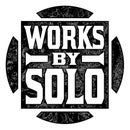Introduction: Christmas Village Scene With USB Powered LED Lighting
This project idea all started when my friend Brenda asked if I could help her create a Christmas/Winter village display for the front windows of her small gift shop, "For The Love of Local". She wanted something different. Something that would give her shop a unique look, and would help to attract customers throughout the Christmas shopping season. It needed to look good during the day, but also at night, with some sort of lighting effect.
She was very helpful in describing what she wanted by giving me some links to a few images of existing displays that she found on Pinterest.
Using the picture reference, actual location measurements, and Brenda's wish-list, I set out to design and build this project. The finished drawings and plans are available for FREE on my website!
Step 1: Tools and Materials
Step 2: Getting Measurements and Ordering Materials
The total window space that I had to work with was 34" wide with a glass width of 30", and I needed to mount the base of my display on the sill board that was about 5" below the glass area. This meant that the scenic details would only be visible from outside if they started above that height. If you build this for yourself, you could reduce the height/depth of the lower box by a couple inches if need be, depending on how you plan to mount the display.
I went shopping for materials on Amazon. When I found the 1/8" and 1/4" Baltic Birch plywood, the most applicable pre-cut size for this project was the 24" x 30" sheets. That's how I determined that the largest panels would stay within a 12" x 30" area. Perfect for the glass width! If you build this just as I did, you will need two sheets of the 1/8" and one sheet of 1/4". If you make more than one, there will be economies.
I think the biggest discovery I made during this project was that the USB LED strips were available in 5(6) volt versions. This means that this display can run off of just a phone charger cube, phone power bank (battery), four "AA" batteries, or even plugged into a laptop USB port!! No need for a special 12 volt power source. The 2 meter (78") length divides evenly into three 26" pieces, which is just right for the 30" box! I also found some USB power switches that could come in handy, depending on how we wanted to turn this on and off.
Step 3: Building the Mock-up (optional)
I needed to build a cardboard and hot glue mock-up as part of my design process in order to make several critical decisions. This included figuring out where to mount the light strips. I did some experimenting to find the best light positions. Fortunately you can skip this step, if you like the way mine turned out, and it fits your needs.
Step 4: Creating the Vector Artwork
I created the vector art in Adobe Illustrator, but could have used any other vector art app just as well. Because I was planning to build five different scenes, I wanted all of the elements to stay independent until I merged them into the backgrounds. I created several buildings that I could move and size as needed. I found the trees on various "Free Vector Art" sites. As I drew the details, I kept an eye on the 1/8" grid to be sure that I wasn't drawing something that was too small to cut with the 1/16" diameter bit. All five scenes are included with the FREE Download.
Step 5: Create the 3D Model and CAM
I used Rhino3D and RhinoCAM for this project, but Fusion360 or any CAD/CAM app would work fine. A 3D model wasn't fully necessary for this project, but I really enjoy modeling and like visualizing things before I build them when possible. The model is included in the FREE download in both Fusion360 and generic STEP formats.
If you are cutting this out on a scroll saw, then this is the time to print out the templates.
If you are using a Laser, prep your files and start cutting.
On the CNC router I prefer to use screws to hold down material on my spoil board, so I usually program in some strategically placed holes as a first machine operation.
Because the 1/16" router bits are quite delicate, I like to give them some room to work. I took the added measures to do a rough profile with a 1/8" bit before using the 1/16" bit to finished the job. It takes extra time, but in my experience, seems to save those little cutters.
Oh yes! I also stuck Santa and his sleigh in some open space on one of the panels!
Step 6: CNC Router, Scroll Saw, or Laser
Time to prep the sheet goods according to your method of cutting.
I used a CNC router, so I went ahead with my procedure of mounting the plywood and running the tool paths.
Step 7: Sanding and Sealing
I had a bit of extra work to do on my routed edges before they were ready for sealer. I sanded the front and back flat surfaces, then used a soft brass brush to remove the majority of fuzzy edges.
If using a scroll saw, you might have a similar situation, but a laser should leave a nice finished edge.
I used a basic shellac as a sanding sealer.
Step 8: Support for Rear Light Strip
The support for the rear light strip can be cut on a 45° angle from a 3/4" x 1-1/2" (1 x 2) board. I used screws to mount this to the back side of the middle panel, but glue will also work fine. By placing the LED strip on this board, at this angle and position, it allows the light to shine higher up the rear panel.
Step 9: Bottom and End Panels
The bottom and end panels are made from 1/4" plywood. Follow the plans for the precise dimensions. Note that the pre-cut plywood may be slightly under-sized. Mine was approximately 3/16" less than the full 30" nominal size. This just means that you may want to adjust the length of the bottom panel accordingly.
Be sure to use a full 1/8" kerf blade for the dados, or make multiple cuts if you have a thinner blade. I drilled the wire access holes to be large enough to allow a USB plug to pass through if need be.
Step 10: Masking and Painting
I wanted to paint everything before assembly. We wanted a matte white finish, so a good quality primer worked great! This meant that I needed to mask the edges so that the final glue joints would be paint free. I used a ruler as a guide to get a straight tape line without having to make any pencil marks.
Step 11: Assembly and Glue-up
I did a dry fit to be sure all the parts were mating together as planned. The 1/8" areas where I masked were just right. Instead of regular yellow wood glue, I opted for white glue so that any excess squeeze-out wouldn't show as much. Instead of regular clamps, I used only large rubber bands to hold it together as the glue dried.
The Santa and sleigh were attached with some small blocks of plywood and a short copper wire. This allows it to be adjustable and removable.
Step 12: Modifying and Mounting the LED Strips
I cut the LED strips into thirds (26" each), making sure to cut only in the marked areas. This allows enough copper to be exposed for soldering the new leads in place. I basically configured a "Y" so that two strips connected to one USB power wire. Heat shrink insulation was applied over all connections.
These strips have a self adhesive backing that is quite sticky. I added a dab of hot glue at each end to be sure they would stay in place and add a little bit of strain relief.
Step 13: All Done!
Step 14: Go Watch the YouTube Video!
I hope enjoyed this Instructable!
Do you like my work?
You can also find me on other social platforms!
• My Website: https://www.worksbysolo.com
• Patreon: https://www.patreon.com/worksbysolo
• YouTube: https://www.youtube.com/worksbysolo
• Instagram: https://www.instagram.com/worksbysolo
• Twitter: https://twitter.com/WorksBySolo
Note: Note: This post contains Amazon Affiliate links. As an Amazon Associate I earn from qualifying purchases. Thank you for supporting what I do!

Second Prize in the
Holiday Decor











